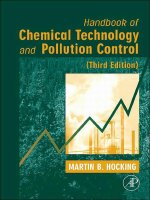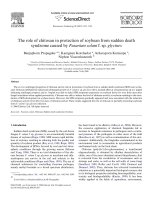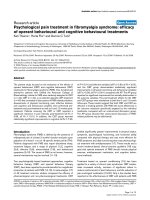Efficacy of fungi toxicants and bio control agents against Fusarium oxysporum f. sp. ciceri
Bạn đang xem bản rút gọn của tài liệu. Xem và tải ngay bản đầy đủ của tài liệu tại đây (226.09 KB, 7 trang )
Int.J.Curr.Microbiol.App.Sci (2018) 7(8): 4592-4598
International Journal of Current Microbiology and Applied Sciences
ISSN: 2319-7706 Volume 7 Number 08 (2018)
Journal homepage:
Original Research Article
/>
Efficacy of Fungi Toxicants and Bio Control Agents against
Fusarium oxysporum f. sp. ciceri
Sonika Jamwal1*, Anamika Jamwal2, Upma Dutta3, A.C. Jha1,
Anil Kumar1, Reena1 and Brinder Singh1
1
3
ACRA-Dhiansar, 2Krishi Vigyan Kendra – Kathua,
Div. of Basic Sciences, Mian Campus, Chatha, Sher -e -Kashmir University of Agriculture
Science and Technology of Jammu, India
*Corresponding author
ABSTRACT
Keywords
Pseudomonas
fluorescens, Trichoderma
viride, Fungitoxicants,
Fusarium oxysporum f.
sp. ciceri
Article Info
Accepted:
26 July 2018
Available Online:
10 August 2018
Bio control agents (Trichoderma viride, Pseudomonas fluorescens) and various
fungitoxicants were tested for their efficacy in controlling the Fusarium wilt of chickpea
caused by Fusarium oxysporum f. sp. ciceri in vitro and in vivo. In vivo conditions soil
inoculated with Fusarium oxysporum f. sp. ciceri was conducted to compare the efficacy
of different treatments viz. seed treatment with bio-control agents and fungitoxicants in the
management of chickpea wilt. All the treatment significantly reduced the wilt incidence.
Bavistin, Thiram and Trichoderma viride were the most effective and reduced the wilt
incidence as compared to inoculated control respectively whereas neem leaf and neem
bark was the least effective over inoculated control. Seed treatment with Pseudomonas
fluorescens and Trichoderma viride effectively enhancing the growth of chickpea viz.
Shoot length, root length, shoot weight and root weight as compared to control. In vitro
condition all the treatments used in vivo conditions were evaluated at different
concentrations for their efficacy is significantly inhibited the radial growth of Fusarium
oxysporum f. sp. ciceri. All the treatments were effective and significantly reduced the
radial growth of Fusarium oxysporum f. sp. ciceri.
Introduction
India grows a variety of pulse crops under a
wide range of agro climatic conditions and it
is the most important pulse crop recorded
production of 5.77 million tonnes/year.
(Masood Ali and Shiv Kumar 2005).
Generally chickpea (Cicer arietinum L.) is
grown under rainfed situation, but it responds
to variable irrigation (Chundawal et al., 1976).
Pulses are an important source of protein in
vegetarian diets being leguminous crops,
processing root nodules, they fix atmospheric
nitrogen. They are thus not dependent on
industrially fixed nitrogen, a process requiring
energy but upto 30kg N/ha to the soil and
4592
Int.J.Curr.Microbiol.App.Sci (2018) 7(8): 4592-4598
improve its fertility (Ahlawat et al., 1997-98).
In general also play a unique role in restoring
the soil fertility by denitrogen fixation through
symbiosis of root nodules bacteria of
rhizobium species and perhaps due to this
reason they have the ability to give good basis
per year more than 75 percent (about 40X106
tonnes per year) is contributed by the pulserhizobium association (Kush and Mishra
1981).
Chickpea is affected by the so many diseases,
among all wilt is most important disease in
India losses about 10-40% chickpea crop. In
chickpea more than one conidium are formed
of these toxins like zearalenone and
sporofusariun are produced from Fusarium.
Fusarium oxysporum is one of the most
common fungi occurring in all types of soil
throughout the world (Burgess, 1981).
Fusarium are known to suppress Fusarium wilt
of chickpea such as Fusarium oxysporum f.
sp. ciceri (Alaboutte and Singh, 2002) The
pathogen is a soil inhabitant, between crops it
survives in infected plant debris in the soil as
mycelium and in all its spore forms but most
commonly, especially in the cooler distances
by means of water and contaminated farm
equipments and over long distances primarily
in infected transplants or in the soil carried
with them, usually once an area becomes
infected with Fusarium, it remains so
indefinitely. In the present investigation
various fungal viz. Trichoderma viride and
bacterial biocontrol agents viz. Pseudomonas
fluorescens chemicals like carbendazim,
thiram and plant extracts viz. neem leaf extract
and neem bark extracts were used to control
the Fusarial wilt under in vitro and in situ
conditions.
In vitro investigation was carried out in radial
growth (in solid medium). Isolation,
identification and purification of test fungus
Fusarium oxysporum f. sp. ciceri and bio
control agents viz. Trichoderma viride and
Pseudomonas fluorescens used in the
experiment was carried out in laminar air flow
under aseptic conditions. In case of Fusarium
PDA medium was used and infected chickpea
plant showing characteristic symptoms was
used, washed the infected portion of plant
were washed and three times sterilized with
0.1% HgCl2 foe 1-2 seconds. Before culturing
infected plants were viewed under microscope
for ascertaining examination of conidia, by
applying HgCl2 tissues get surface sterilized
so as to minimize the contamination. Already
sterilized, melted PDA medium was
transferred into petriplates and then small
pieces of infected roots of the chickpea were
kept on semi-solidified media inside
petriplates. The whole process was done under
laminar flow and petriplates were kept under
BOD incubator after 3 days white cotton
growth of mycelium was observed in
petriplates and slight portion was taken under
microscope for confirming the pathogen. The
mycelium of fungus is cottony, hyaline,
branched, septate multinucleate. The fungus
can be cultured on simple media, growing
profusely and produces three types of asexual
spores, i.e. macroconidia, microconidia and
chlamydospores, with in test tissue as well as
in cultures. Similarly commercial bio control
agents viz. Trichoderma viride trade name
Nisarga bacterial bio control agents viz.
Pseudomonas fluorescens trade name Sparsh
marketed by Agro chemicals 1st main road,
Mahalaxmi, layout Bangalore 560086, India.
Materials and Methods
Viability and population assessment test of
the product
The investigation in vitro and in vivo was
carried out Advanced Centre for Rainfed
Agriculture, Dhiansar.
Commercial formulation of Trichoderma
viride and Pseudomonas fluorescens were
tested for their viability and population
4593
Int.J.Curr.Microbiol.App.Sci (2018) 7(8): 4592-4598
assessment test before using in the
experiment. 1g of product was weighed and
made upto 10 ml. suspension was taken and
transferred to 9ml. of sterilized water in a test
tube (1:100). Serial dilution was made
similarly transferring 1ml of the suspension to
the subsequent tubes to get 1:1000000 dilution
1ml of the 1000000 suspension was
transferred to sterile petriplates. 15 ml of
melted and cooled PDA was poured in
petriplates for assessment of Trichoderma
viride and Pseudomonas fluorescens. The
plates were rotated gently and allowed to
solidify. The plates were incubated at room
temperature, after 48 hours average number of
colonies per plates was calculated. Five
colonies in case of Trichoderma were found
and the no. of c. f. u. present in 1g of the
product was calculated by formulae:
No. of colonies
c. f. u. in /g product = ----------------------------Amount placed X dilution
c. f. u. of Trichoderma viride in 1g product =
(5/1 X 10-6) =5X 106 c. f. u/g
c. f. u. of Pseudomonas fluorescens in 1g
product = (6/1 X 10-6) =6 X 106 c. f. u/g
Fungal biocontrol agents viz. Trichoderma
spp. have been widely explored and
recommended against many soil borne soil
fungal diseases (Elad, Y., Chet, I and Katan, J.
1980).The use of Trichoderma as a fungal
biocontrol agent in the control of plant
pathogens along with other disease
management (Papavizas 1980), use of bacteria
for management of plant diseases and yield
improvement has increased steadily since the
mid 1960b (Baker, 1987). In vitro the fungal,
bacterial, chemicals and plant extracts were
tested against Fusarial wilt in solid as well as
in liquid. The fungitoxicants used in the
experiment were evaluated by poisoned food
technique methods (Nene and Thapiyal 2000)
in it incorporation of nutrient medium with a
toxic chemical and then allowing test fungus
to grow on such a poisoned food.
In the in vivo experiment the seeds were
dressed as per the treatment. The test fungus
Fusarium was multiplied on sorghum medium,
100g of sorghum was crushed and sorghum
was taken in conical flasks and was sterilized
in an autoclave at temp. 1210C and 15lbs
pressure for 20 minutes. Inoculate each
conical flask with carried sorghum with 2
discs measuring 5mm of test fungus at 250C.
The pathogen Fusarium oxysporum f. sp.
ciceri multiplied on sorghum medium was
applied @100g/plot. Seeds were dressed with
commercial formulation of T. viride and P.
fluorescens 4g/kg seed, similarly carbendazim
and thiram 3g/kg of seed before sowing seeds
treated were kept in shade for few hours
before sowing to dry up. Similarly the neem
leaf extract and neem bark extract @ 4g/kg of
seed before sowing treated were kept in shade
for few hours before sowing to dry up.
Statistical analysis: In the investigation
Randomized Block Design was adopted. The
analysis of variance technique was applied for
drawing conclusion from the data. The
calculated values of F were compared with the
tabulated value at 5% level of probability for
the appropriate degrees pf freedom the
skeleton of analysis of variance table. The data
obtained were statistically analyzed using
“Analysis of variance” technique and “Critical
difference” as by P. G. Panse and P. V.
Sukhamte. Indian Council of Agriculture
Research New Delhi (1967).
Results and Discussion
Under in vitro conditions with dual culture
techniques on solid media the minimum
growth of Fusarium oxysporum f. sp. ciceri
was recorded from day 1 to day 8 after every
24 hours.
4594
Int.J.Curr.Microbiol.App.Sci (2018) 7(8): 4592-4598
Table.1 Antagonistic efficacy of fungi toxicants and bio control agents against Fusarium oxysporum f. p. ciceri
(Dual culture technique)
Treatments
T1(inoculated control) F. o.
T2 (F. o. + T. v.)
T3 (F. o + P. f.)
T4 (F. o + NL extract6%)
T5 (F. o + NB extract6%)
T6 (F. o + carbendazim.100ppm)
T7 (F. o + Thiram100ppm)
CD
SE (m)
Radial growth of Fusarium oxysporum f. sp. ciceri (mm) in days
D1
D2
D3
D4
D5
D6
11.99
18.36
28.21
37.44
47.24
56.22
10.61
9.63
8.61
7.61
6.61
5.03
5.40
5.80
6.20
6.65
7.25
7.62
3.94
5.10
6.03
6.54
7.73
8.41
3.10
5.03
6.13
6.93
8.17
9.27
3.30
5.31
6.30
7.61
8.54
9.35.
2.97
5.19
6.18
7.28
8.30
9.12
0.244
0.241
0.178
0.548
0.186
0.579
0.080
0.079
0.058
0.179
0.061
0.189
D7
67.77
3.64
8.52
9.41
10.12
9.82
10.07
0.266
0.887
D8
80.68
2.35
8.61
10.20
10.55
9.07
11.35
0.404
0.132
Each value is mean of three replicates
F. o = Fusarium oxysporum, T. v. = Trichoderma viride, P. f. = Pseudomonas fluorescens, NL= Neem leaf, NB= Neem bark. D = Days
Table.2 Effect of biocontrol agents and fungitoxicants on the wilt of chickpea caused by Fusarium oxysporum f. sp. ciceri (pooled
data of both the years)
Treatments
30 DAS
Wilt
incidence
20.3
3.30
8.00
12.00
13.30
2.60
3.00
11.30
0.863
1.852
60 DAS
% reduction in wilt incidence over
inoculated control
00
83.70
57.63
40.88
34.48
87.19
85.22
44.30
Wilt
incidence
30.60
5.60
11.60
14.60
15.30
3.60
5.00
16.30
1.188
2.548
% reduction in wilt incidence over
inoculated control
00
81.70
62.09
52.29
50.00
88.66
83.60
46.73
T1(inoculated control) F. o.
T2 (F. o. + T. v.)
T3 (F. o + P. f.)
T4 (F. o + NL extract6%)
T5 (F. o + NB extract6%)
T6(F. o + carbendazim 100ppm)
T7 (F. o + Thiram100ppm)
T8 (uninoculated)
CD
SE (m±)
Each value is mean of three replicates
F. o = Fusarium oxysporum, T. v. = Trichoderma viride, P. f. = Pseudomonas fluorescens, NL= Neem leaf, NB= Neem bark. D = Days
4595
Int.J.Curr.Microbiol.App.Sci (2018) 7(8): 4592-4598
Table.3 Effect of bio control agents and fungitoxicants on the growth parameters after 30 DAS and 60 DAS
Treatments
Shoot length (cm)
Root length (cm)
Shoot weight (g)
Root weight (g)
30DAS
60DAS
30DAS
60DAS
30DAS
60DAS
30DAS
60DAS
T1(inoculated control) F. o.
5.00
13.05
4.60
5.27
3.20
6.60
1.90
4.80
T2 (F. o. + T. v.)
17.30
36.80
6.80
12.33
18.60
33.50
15.30
21.40
T3 (F. o + P. f.)
19.78
41.20
7.35
15.06
21.40
39.60
20.60
23.03
T4 (F. o + NL extract6%)
14.80
25.30
6.20
8.63
10.00
20.81
9.00
13.43
T5 (F. o + NB extract6%)
14.79
24.70
6.07
8.33
9.00
21.50
8.50
13.60
T6(F. o + carbendazim 100ppm)
12.00
22.00
5.85
8.10
8.90
20.80
8.40
13.50
T7 (F. o + Thiram100ppm)
12.30
22.50
5.90
8.16
9.30
21.20
8.70
13.30
T8 (uninoculated)
9.50
16.00
5.15
6.93
5.90
19.03
5.30
9.70
CD
1.15
1.00
0.233
0.448
1.03
0.72
0.810
1.063
SE (m±)
2.46
2.145
0.500
0.960
2.21
1.54
1.740
2.280
Each value is mean of three replicates.
4596
Int.J.Curr.Microbiol.App.Sci (2018) 7(8): 4592-4598
In case of bio control agents the 5mm disc
was placed at the periphery of the petriplate and
test fungus was placed on the another periphery
of the petriplates. At day 1 the radial growth
was minimum with neem bark extract (3.10mm)
followed by carbendazim (3.30mm), after 24
days at 2nd day the minimum radial growth was
with neem bark extract (5.03mm) followed by
neem leaf extract (5.10mm), at third day the
minimum radial growth was with neem leaf
extract (6.03mm) followed by neem bark
extract. At the 4th day the minimum radial
growth was with neem leaf extract (6.54mm)
followed by neem bark extract (6.93mm), again
after 24 hours on 5th day the minimum radial
growth was with Trichoderma viride (6.61mm)
followed
by
Pseudomonas
fluorescens
(7.25mm) (Table 1).
At 6th day the minimum radial growth was with
the Trichoderma viride (5.03mm) followed by
Pseudomonas fluorescens (7.62mm). With the
increase in days the radial growth was
minimum with the biocontrol agents. At the 7th
day the radial growth of pathogen was
minimum was with Trichoderma viride
(3.64mm)
followed
by
Pseudomonas
fluorescens (8.52mm). At the 8th day the
minimum radial growth of pathogen Fusarium
oxysporum f. sp. ciceri was with Trichoderma
viride (2.35mm) followed by Pseudomonas
fluorescens (8.61mm).
In vivo experiment
Effect of bio-control agents and fungitoxicants
on the wilt incidence: It was revealed that the
seed treatment with Trichoderrma viride,
Pseudomonas fluorescens, Bavistin, thiram,
neem leaf extract and neem bark extract in all
the treatments were significantly effective in
controlling the wilt incidence as compared to
inoculated control. At 30 DAS and 60 DAS the
minimum wilt incidence was recorded with
bavistin and followed by thiram and next
followed by Trichoderma viride. Seed dressing
with thiram eradicate seed borne inoculum and
seed treated with Bavistin decreased Fusarium
oxysporum f. sp. ciceri. Seed treatment with
Bavistin increased number of nodules/plant and
maximum grain yield in cicer arietinum were
obtained. Seed treatments are required to
completely eradicate the disease and the
antagonist moved to the rhizosphere and
survived well in it controlled chickpea wilt.
Similarly Trichoderma viride was used which
showed profound effect over Fusarium
oxysporum f. sp. ciceri causing wilt of Cicer
arietinum. Plants effects were effective in
decreasing the prevalence of seed borne fungi.
Similar findings have been reported by earlier
scientists viz. Zaman et al., (1997), Ushamalini
et al., (1997), Hemani and Bhatnagar et al.,
(1996) (Table 2).
Effect of seed treatment of antagonist on the
shoot length, root length, shoot weight and root
weight of chickpea of chickpea under field
condition:
The
seed
treatment
with
Trichoderma
viride,
Pseudomonas
fluorescence, bavistin, thiram, neem leaf extract
and neem bark extract in all the treatments were
significantly effective in enhancing the growth
of chickpea i.e. shoot length, root length, shoot
weight and root weight production as compared
to control. The treatment T3 (Fusarium
oxysporum f. sp. ciceri + Pseudomonas
fluorescens) was more effective in comparison
to other treatments at 30DAS and 60DAS
(Table 3). Moreover fluorescent Pseudomonas
produced plant growth promoting substances
such as auxin and gibberlins and enhanced
growth of plant and its yield. Enhancement of
growth of chickpea viz. shoot length, root
length, shoot weight and root weight confirm to
the earlier workers (Defago et al., 1990;
Rangeshwaran and Prasad, 2000).
References
Ahlawat, I. P. S., Prakash Om and Sain, G. S.,
(1997-98). Scientific crop production in
India, Gram, Importance and utility pp
150.
Alaboutte, C and Singh, R. S. (2002) Biological
control of Fusarium wilt by fluorescent
Pseudomonas
and
non-pathogenic
4597
Int.J.Curr.Microbiol.App.Sci (2018) 7(8): 4592-4598
Fusarium, Final Reports of Project
(IFCPAR, New Delhi), Department of
Plant Pathology, PAU Ludhiana and
INRA UMR BBCE IPM, Dijon, France
pp.54.
Amarender, R. and Devraj, M., Growth and
instability in chickpea production in
India. www.krisat.org Accessed on 15
February 2011 (2010).
Baker, K. F. (1987). Evolution concepts of
biocontrol of plant pathogens, Ann. Rev.
of Phytopathology 25:67-85.
Baker, K. F. and Cook, R, R. J (1987).
Biological control of Plant Pathogens,
IInd Edn. American Phytopathology
Society St. Paul, M. N. 433p.
Burgess, L. W. (1981). General ecology of the
fusaria. Fusarium diseases, Biology and
Taxonomy, (Eds. Nelson, P.E., Toussoun,
T. A. and Cook, R. J), pp. 225-235.
University Park PA, USA.
Chundawal, G. S.., Sharma R. G. and
Shekhawat, G. S (1976). Effect of
nitrogen, phosphorous and bacterial
fertilization on the growth and yield of
gram in Rajasthan. Indian Journal of
Agron. 21:127-130.
Defago, G., C. H. Berling., U. Berger, D. Hass,
G. Kahr., K. Kee, C. Vaisarel., P.
Wirthner and B. Wuthricl (1990).
Suppression of black root rot of tobacco
and other root diseases by strains of
Pseudomonas
fluorescens
potential
application and mechanism. Biological
control of Soil- Borne
Elad, Y., Chet, I and Katan, J (1980).
Trichoderma harzianum, a bio control
agent effective against Sclerotium rolfsii
and Rhizoctonia solani Phytopathology
70-119.
Faruk, M. I., Rahman, M. L. and Bari, M. A.,
(2002). Management of seedling disease
of cabbage
through
Trichoderma
harzianum amendment in seedbed. Bangl.
J. Plant Pathol., 18(1-2): 49-53 (2002).
Gupta, S. K., Upahyay, J. P. and Ojha, K. H.,
Effect of fungicides seed treatment on the
incidence of chickpea wilt complex. Ann.
Pl. Prot. Sci., 5:184-187 (1997).
Himani, B and Bhatnagar, H (1996). Influence
of
environmental
conditions
on
antagonistic activity of Trichoderma spp.
against Fusarium udum. Indian udum.
Indian Journal of Myco. And Plant
Pathology. 26(1):58-63.
Kush, A. K and Mishra, A. K. (1981). Wonders
of rhizobium. Indian Fng., 31(5) 84-85.
Masood Ali and Shiv Kumar 2005. Pulses yet to
see a breakthrough. The Hindi Survey of
Indian Agriculture. 54-56.
Nene, Y. I. and Thapiyal, P. N., In: Principals of
pesticides. Oxf. IBH Publ. New Delhi.
3rd edition. p. 691(1993).
Papavizas, G. C and Lumsden, R. D (1980).
Biological control of soil-borne fungal
propagules.
Annual
Review
of
Phytopathology, 18-389.
Ushamalini, C., Rajappan, K and Kousalya,
Gangadharan (1997). Control of cowpea
wilt by non-chemical means. Plant
disease Research. 12(2):122-129.
Zaman, M. A.., Saleh, A. K. M., Rahman G. M.
M and Islam, M. T. (1997). Seed borne
fungi of legumes and then control with
indigenous plant extract. Bangladesh.
Journal of Plant Pathology 13 (1/2) 25-28.
How to cite this article:
Sonika Jamwal, Anamika Jamwal, Upma Dutta, A.C. Jha, Anil Kumar, Reena and Brinder Singh.
2018. Efficacy of Fungi Toxicants and Bio Control Agents against Fusarium oxysporum f. sp.
ciceri. Int.J.Curr.Microbiol.App.Sci. 7(08): 4592-4598.
doi: />
4598









